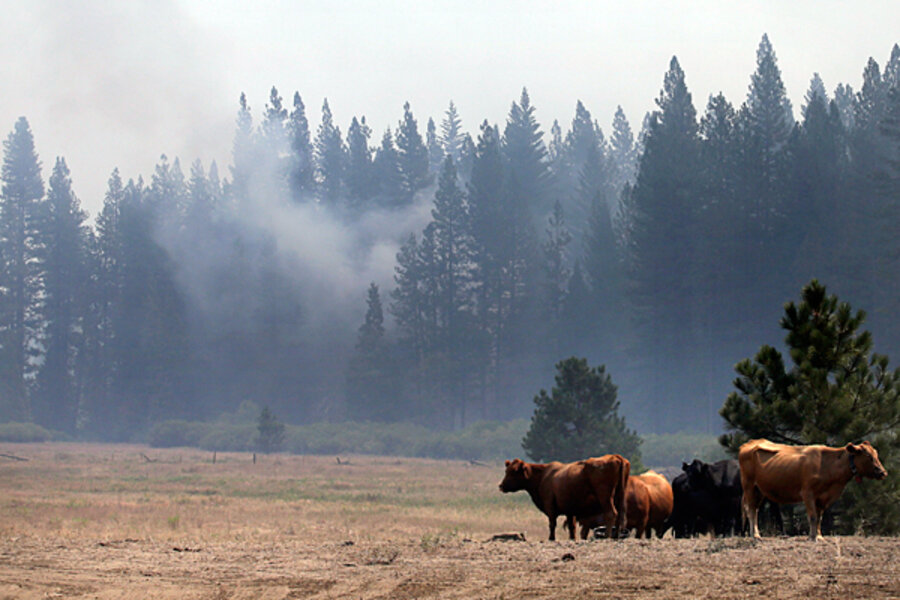Yosemite Rim Fire: why there's more optimism about taming it
Loading...
| Los Angeles
Although the Yosemite Rim Fire is still raging and expanding – now at 193,000 acres – there are reasons for optimism, several officials and fire experts say. But given that Yosemite is a national park with wilderness-protected rivers, there are also very specific challenges.
The rate of the fire's spread has slowed considerably since last week. The blaze is currently 30 percent contained, and full containment is now expected by Sept. 10, according to the California Department of Forestry and Fire Protection.
Cooler temperatures, higher humidity, and lighter winds are giving firefighters more time to get where they need to be – in particular, to ignite smaller fires in the expected path of the larger conflagration, so the bigger fire is deprived of fuel when it gets there.
"I think we've got a really good anchor on this thing,” Dick Fleishman of the US Forest Service told the Los Angeles Times. "The plan of attack is to just keep going on the containment lines and march on the northwest side and keep flanking on the bottom side and get around it."
Officials are employing unmanned drone aircraft for the first time against the Rim Fire. Operated from afar – the March Air Reserve Base in Riverside County, Calif. – the drone is about the size of a small Cessna. It is a cheaper, more efficient tool for strategists to better understand where the fire is going and how it is behaving.
Because the aircraft are equipped with infrared heat sensors and a swiveling camera operated by a remote pilot, they are especially valuable for beaming real-time pictures to commanders, who can make tactical adjustments on the ground more quickly.
Also, they don’t get in the way of lower-flying reconnaissance helicopters and planes that are dropping fire retardants.
Perhaps the biggest reason for optimism is that the fire is now reaching areas already scorched in 2003 and 2005-06.
“The intensity of the fire and the rate of its spread are greatly reduced when the flames reach these already-burned areas, because the fuel source is pretty much used up,” says Jan van Wagtendonk, research forester emeritus for the US Geological Survey’s Yosemite Field Station. “And the Fire Service with incident teams are all over the place doing burnout operations to stop the path of the fire in all the most opportune places, based on the bigger picture they are able to get from above.”
Although it’s been imperative to concentrate on the fire’s containment, some experts worry that it may have meant ignoring longer-term planning, to the possible detriment of wildlife.
“To focus on the resources that are being poured into the firefighting efforts at the Rim fire is to miss what I think are two major points,” says Char Miller, a professor of environmental analysis and a firefighting expert at Pomona College in Claremont, Calif.
The first, he says via e-mail, is that such high-intensity fires have often occurred before and “are ecologically quite useful, opening up dense forest so that other species can take advantage of the charred terrain.” Among them are the black-backed woodpecker, deer, black bears, and the rare Pacific fisher.
“The second issue is that we tend to narrow in on the immediate moment, the fire and its containment, when we need as well to start the planning for when the fire dies out,” Professor Miller writes. This is particularly essential for San Francisco and other communities that secure some of their potable water from the Hetch Hetchy reservoir, he says.
"Post-fire debris flows from winter storms could wreak havoc on this system," Miller says, adding, "and thus impact millions of Bay Area residents who depend on its flow and the electricity it produces.”
There are still immediate challenges. Because the fire has entered Yosemite National Park, firefighters – now at 4,400 – are restricted in what they can do. With much of the park designated as wilderness, vehicles and even roads are prohibited by federal law. Therefore, fire commanders can’t deploy bulldozers to plow fire lines, and crews can’t go in with firetrucks.
In exceptional situations, officials order smoke-jumping crews to parachute into backcountry and drop supplies and tools.
Also, the Tuolumne and Merced Rivers have federal designations as wild and scenic rivers, meaning hand crews have to avoid clearing around the rivers and fire aviation managers need to give the rivers wide berth when dropping retardant.
One promising sign: The Rim Fire is now burning into areas of Yosemite National Park that have had several past managed wildfires, says Scott Stephens, professor of fire science at the University of California, Berkeley.
“I believe these past fires will have a big influence on the Rim Fire and if the previous area has been burned in 10 or less years, the fire will go out on its own,” he writes in an e-mail.





